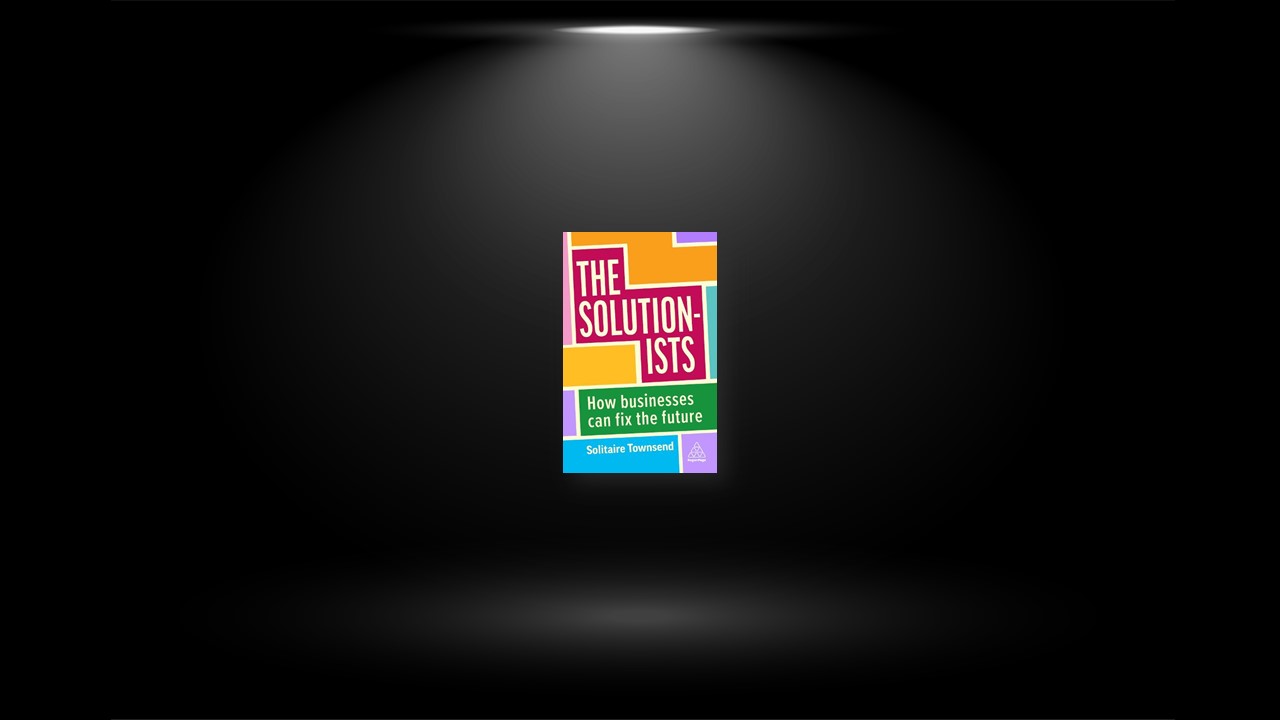The magic of changing your mind
Albert Einstein apocryphally once said that ‘we cannot solve our problems with the same thinking we used when we created them’ – and when it comes to being a Solutionist, he couldn’t be more right.
So many of the problems we find ourselves in today spring from the same cradle – our take–make–use–waste manufacturing economy, exploitative employment structures, poverty-dependent commodities and the big bad of climate change. They stem from our ongoing loyalty to Victorian mercantile models and our dedication to maintaining them in a globalized and technological economy over 100 times larger than when those laws of capitalism were laid down.
A core attribute of Solutionists is how they dump useless approaches and swiftly flex to innovative ways of thinking. That speed and adaptability of thinking is desperately needed to build our new Solutions Economy.
You may be familiar with a famous puzzle involving a candle, some drawing pins and a box of matches? Your challenge is to mount the candle on the wall and light it. You try pinning the candle to the wall, but the wax is too hard and the pins too short. What do you do?
The answer requires us to overcome what German psychologist Karl Duncker called ‘functional fixedness’. This is a type of cognitive bias that describes the human brain’s tendency to see objects only in terms of the function we know them for. It’s a shortcut that helps us cope with the vast amount of information in the world – but it’s the enemy of creative problem solving.
So much of our current infrastructure, business models and social norms are functionally fixed, and the exploitation and destructive extraction they depend upon are similarly baked in. Solutionists are twisting themselves free of these outdated systems and daring to imagine functional fluidity and transformation.
First, fall in love with failure
Many of the most successful Solutionists are remarkably fond of failure. By its very nature, doing something new and different, something better for people and planet, is difficult. Failure is baked into the process – indeed, it is the only way to find success.
So, while you obsess about your goals, you need to stay fluid and experimental with how you reach them. Hold your plans lightly and be ready for them to change. Which is to say, you should foster what is called an ‘adaptive mindset’ by psychologists. Adaptive thinking requires you to embrace what others shy away from – it welcomes change, is excited by new perspectives and sees setbacks as opportunities.
Flex your mindset
Flexible or adaptive thinking is critical to what scientist Carol Dweck calls the ‘power of yet’. In her research with schoolchildren, she found that when confronted with a written problem that was slightly too advanced for them to solve, the kids reacted in one of two ways.
Some felt they had failed catastrophically, that their intelligence had been judged and found wanting. This is what Dweck termed a ‘fixed mindset’. Others responded quite differently, seeing the too-hard test as a challenge they could enjoy learning to overcome. They had a ‘growth mindset’: the ability, as Dweck puts it, to ‘luxuriat[e] in the power of yet’, instead of being ‘gripped in the tyranny of now’. Not only do children with growth mindsets feel less distressed when they don’t pass a test, they also perform better, over time, than those with fixed mindsets (Dweck, 2014).
Both success and sanity for Solutionists lie in cultivating this flexible mindset. After all, anyone can learn to be better at anything, including having a growth mindset. That’s exactly the point.
Don’t sink your costs
A real struggle for Solutionists is when they find the wrong solution. It happens, and it doesn’t mean you are any less of a Solutionist – just that you must keep trying.
The reason we cling onto projects, ideas and answers that no longer serve us is because humans carry a weird bias that many other animals don’t: we commit the ‘sunk-cost fallacy’. This is what happens when you sit down at the cinema to watch a film you’ve been desperate to see, but halfway through realize it’s not all it’s cracked up to be. You’re bored, fidgety and thinking about what else you could be doing. You’ve come all the way here and paid for your ticket, so leaving now would be a waste, right? You sit it out until the credits roll. The reality is that doing so didn’t get you your money back, and only cost you more wasted time.
It’s difficult to let go of the idea of a sunk cost, but let go we must. Solutionists’ worlds revolve around outcomes. This means looking, focused and unwavering, at the future, not the past. If plan A hasn’t taken you closer to your outcome, drop it like a hot potato. The efforts and resources ploughed into it in recent weeks, months, years – that time resource should not dictate your decision to stick or twist. It belongs to yesterday, and your vision lives on the horizon of tomorrow.
Let’s get gritty
Being flexible, learning to love failure and dodging the sunk-cost fallacy are bends in the curve of the river. What doesn’t change is the relentless flow of water. While you are going to adapt to what you learn on the way, you’re never going to stop moving towards your goal.
Solutionists had hit moments where they’d adapted, they’d invented, they dodged and weaved to get their solution into reality, but it still wasn’t working. Their solutions were right, but the market wasn’t quite ready. Probably, millions of other people who were trying to get going also sat, dejected, on the very same day. What distinguished the Solutionists was that they didn’t allow dejection to become defeat. Many people who have given up on their goals because the course meandered too much might have had brilliant ideas. Only those with tenacity made them happen.
Calculated grit
Angela Duckworth is a renowned psychologist whose research has uncovered two fascinating truths about this magical tenacity.
First, tenacity often predicts success more reliably than talent or IQ; and second, that anyone, adult or child, can learn to be gritty. These two revelations are great news for all Solutionists. Hard work beats natural talent and grit can be grown.
You gotta love what you do – sometimes we need grit to survive, to make it through hard times, to feed the family even though you’re too dog-tired to stand. That’s a grit which I’ve known, and that people are waking up to every day. I salute them for it. There’s another grit though, and one that
Solutionists work with and hold onto their vision for the sheer fun of it! Being excited by, enjoying working on, and finding joy in our solution is the very best way to never be defeated. That’s why fun balances grit on opposite sides of the star.
Find a tenacious tribe – isn’t it always easier working hard when others around you are doing the same? And near impossible to buckle down surrounded by folks who are kicking back and want to chat? Tenacity is surprisingly infectious for something we too often consider an inner virtue.
Grit loves good company.
Eyes on the horizon
Solutions rarely come quickly, and the bigger the potential the longer those huge rewards will take to realize. Every single Solutionist has a long-term heart and short-term hands. They are tenacious and bold in the choices they make, and swiftly adapt to boulders in their path, because they cleave only to their purpose, not to any particular project, product or process.
Ezgi Barcenas, Chief Sustainability Officer at AB InBev, explains how that works in practice. ‘I don’t shy away from rolling up my sleeves. What we do is not just about being hopeful and positive about the future, it’s actually urgently working towards that positive future that you believe in. Ask yourself “if not me, who?” If there’s a problem, let’s just dig in and solve it.’
In the end, all of the twists and tumbles, flows and fights of the river are simply a means for the water to reach the vastness of the ocean – its home.
Fill your stack
The phrase comes from computer science. Software developers layer up different pieces of software to produce a ‘full-stack’ solution that will work in our complex online world. Even the most basic website tends to have a solution stack of operating system, middleware, database and applications. The best digital experts are called ‘full-stack’ developers because they can build in all the component parts of a functional website, from the friendly user experience to the complex back-end of programming language.
This is an excellent metaphor for the modern Solutionist. Rather than just specializing in one part of our solutions stack, say solar energy, we need to become masters of the entire stack, of solar energy, equitable energy access, non-exploitative mineral mining, climate justice and end-use recycling of the panels. Our solutions must consider not just the original answer that we thought up, but our product, service or business model’s full impact on society (or environment if your solution is social)
Full-stack Solutionists understand that every answer needs to be intersectional. Thankfully, we know that with a little thought, full-stack solutions can serve climate justice, intersectional environmentalism, equity and just transitions – all at once.
Multiply your wins
More often than not, the wins needn’t stop there. The thing about tackling the world’s biggest problems is that none exists in isolation. The mess that our planet finds itself in is the product of systemic problems that run deep. When acidifying oceans disrupt underwater ecosystems, they also affect fishing communities’ livelihoods. When clothes are mass produced with toxic dyes, habitats suffer, workers are harmed and the world’s supply of safe drinking water is undermined. The same air pollution that leads to unpredictable weather patterns also damages the health of children’s lungs.
Not only do the problems interlink, so too do the solutions. Address one issue and another is solved with it. Reduce our carbon emissions to stop the oceans acidifying, and marine life can thrive along with fishing communities’ income. Banish toxic fabric dyes and the fish surrounding a factory benefit, along with the factory’s employees and those who rely on the local water supply. Reduce gas-guzzling car fumes to slow down extreme weather while also protecting kids’ health.
There’s every chance that with the right approach, your solution could have many facets – it could be a gem that reflects light on a glittering array of human and planetary health. And when it does, my goodness, it’s beautiful to behold.


